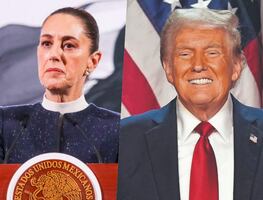Más Información

Familias de desaparecidos en Mazatlán irrumpen en evento de Sheinbaum; mandataria promete atender peticiones

Sheinbaum responde a Trump sobre declarar a cárteles como organizaciones terroristas; rechaza injerencia extranjera

PAN exige renuncia de Rubén Rocha Moya; Claudia Sheinbaum sigue protegiéndolo en “complicidad vergonzante”

No cesaremos ni nos rendiremos en nuestro llamado a la paz y justicia: Iglesia; pide ser persistentes en exigencia
Permissive land-use policies
and cheap farm acreage have helped catapult Brazil into an agricultural superpower , the world’s largest exporter of soy , beef and chicken , and a major producer of pork and corn , luring farmers and ranchers away from the Amazon jungle , whose decline has spurred a global outcry to protect it.
The tradeoff , environmentalists say, is that while Brazil has slowed destruction of the renowned rainforest from its worst levels, it has put another vital ecological zone at risk : a vast tropical savanna that is home to 5% of species on the planet.
Known as the Cerrado , this habitat lost more than 105,000 square kilometers ( 40,541 square miles ) of native cover since 2008, according to government figures. That’s 50% more than the deforestation seen during the same period in the Amazon, a biome more than three times larger. Accounting for relative size, the Cerrado is disappearing nearly four times faster than the rainforest.
The largest savanna in South America , the Cerrado is a vital storehouse for carbon dioxide , the greenhouse gas whose rising emissions from fossil fuels and deforestation are warming the world’s atmosphere. Brazilian officials have cited protection of native vegetation as critical to meeting its obligations under the Paris Agreement on climate change . But scientists warn the biome has reached a tipping point that could hamper Brazil’s efforts and worsen global warming.
By focusing on one problem, Brazil essentially created another, said Ane Alencar , Science Director of the Non-profit Amazon Environmental Research Institute , known as IPAM .
“There’s a high risk for the climate associated with this expansion,” Alencar said. “Limiting and calling attention to deforestation in the Amazon , in a way it forced the agribusiness industry to expand in the Cerrado .”
The toll can already be seen in the region’s water resources . Streams and springs are filling with silt and drying up as vegetation around them vanishes. That, in turn, is weakening the headwaters of vital rivers flowing to the rest of the country, scientists say. The imperiled waterways include the Sao Francisco , Brazil’s longest river outside the Amazon , where water levels are hitting never-before-seen lows in the dry season.
“The removal of vegetation can lead a body of water to extinction ,” said Liliana Pena Naval , an environmental engineering professor at the Federal University of Tocantins .
Wildlife
, too, is under threat, including rare hyacinth macaws , maned wolve s, and jaguars that call the shrinking savanna home. So are thousands of plants , fish , insects and other creatures found nowhere else on earth, many of which are only beginning to be studied.
“I compare it to the burning of the ancient Library of Alexandria ,” said Mercedes Bustamante , an Ecologist at the University of Brasilia . “You lose the accumulated evolutionary record of thousands of years that never can be recovered.”
Farmers see the Cerrado’s development as critical to global food security and their nation’s prosperity . Brazil’s agriculture sector grew a sizzling 13% in 2017, while the overall economy barely budged. The nation’s ability to keep producing new farmland cheaply has given it an edge over rivals and cemented its status as a vital supplier to the world’s tables.
Roughly the size of
Mexico
, straddling Brazil’s midsection from its far western borders with Paraguay and stretching northeast towards the Atlantic coast , the Cerrado has seen about half of its native forests and grasslands converted to farms , pastures and urban areas over the past 50 years.
Deforestation in the region has slowed from the early 2000s when Brazil’s soy boom was gaining steam. Still, farmers continue to plow under vast stretches of the biome, propelled largely by Chinese demand for Brazilian meat and grain . The Asian nation is Brazil’s No. 1 buyer of soybeans to fatten its own hogs and chickens . China is also a major purchaser of Brazilian pork , beef , and poultry to satisfy the tastes of its increasingly affluent consumers.
Rising trade tensions between China and the United States have only deepened that connection. Brazil’s soybean exports by value to China are up 18% through the first seven months of the year as Chinese buyers have canceled tens of millions of dollars’ worth of contracts with U.S. suppliers.
On a brighter note, dozens of groups, including Greenpeace , the World Wildlife Foundation , and the Brazilian research group IPAM , last year began pushing for large multinationals to protect the biome. In a document known as the Cerrado Manifesto , they called for immediate action to stop deforestation in the region.
More than 60 companies, including McDonald's , Unilever , and Walmart , have signed on so far. The firms have agreed to support measures that would eliminate native vegetation loss in the Cerrado from their supply chains. But in contrast to the 2006 Amazon soy moratorium , the Cerrado Manifesto did not commit signatories to halt purchases of farm products from newly deforested areas.
sg






